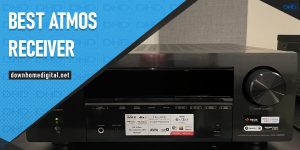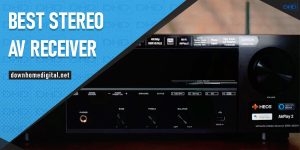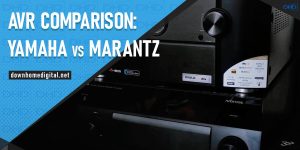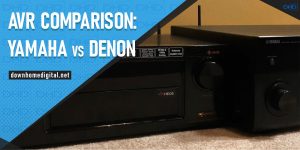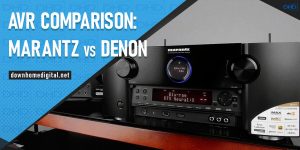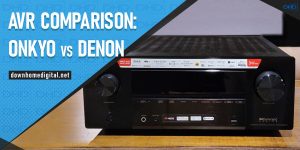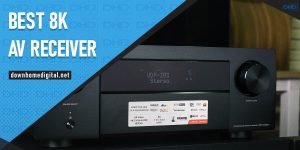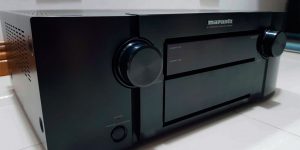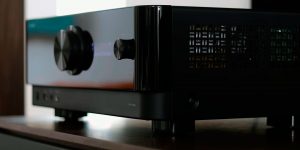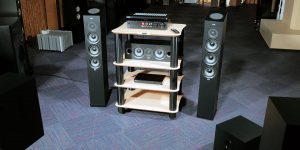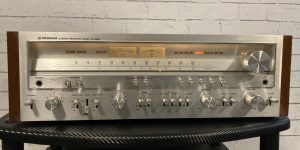The history of the Yamaha company started in 1887 when a talented Japanese designer Torakusu Yamaha created his first reed organ. At that period, the sphere of musical instruments was poorly developed, so Thorakusu worked hard to offer something interesting and innovative. Over 100 years, the brand has been creating all types of musical equipment and related accessories, so no wonder so many audiophiles and movie lovers nowadays are willing to spend any money to purchase the best Yamaha receiver.
Today, checking the official Yamaha website, you are bound to be amazed by how extensive the assortment is. I was solely interested in their receivers, and this single niche comprises a plethora of state-of-the-art options. From basic 4K receivers to advanced receivers with a 4-digit price tag, you can find something to suit your needs and budget. The common thing about all Yamaha receivers is their recognizable sounding with powerful bass and defined half-tones.
If you want to make the right choice but do not know where to start looking, my review will definitely help you. I selected the most popular Yamaha receivers and tested their capabilities to provide a truthful and unbiased opinion.
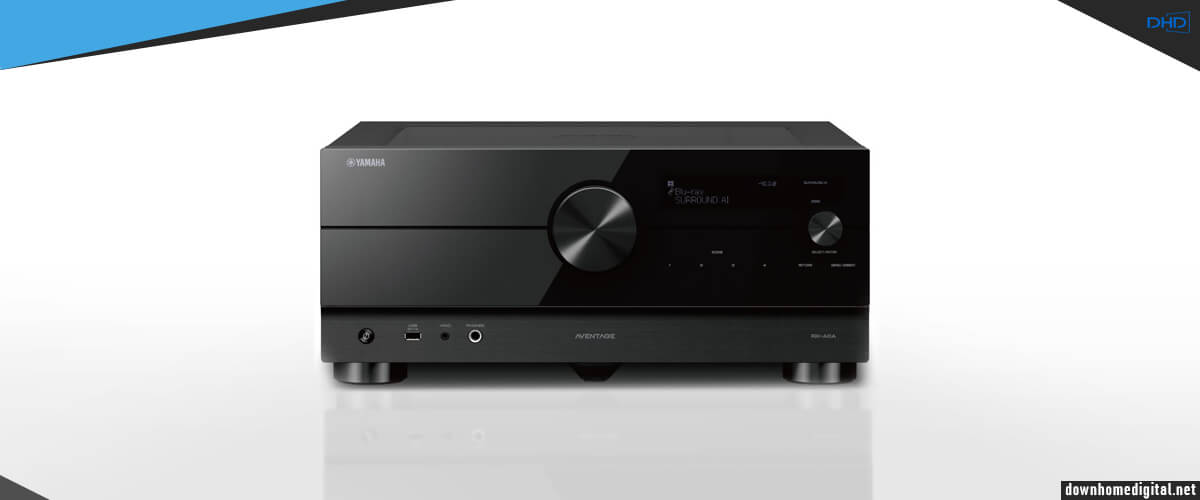
Yamaha Receivers comparison table
| Name | Channels | Power output | HDMI in/out | Bluetooth/Wi-Fi | Review |
|---|---|---|---|---|---|
| Yamaha RX-A6A best overall | 9.2 | 110W/8 Ohm | 7/3 | yes/yes | Review |
| Yamaha RX-A4A also a great choice | 7.2 | 110W/8 Ohm | 7/2 | yes/yes | Review |
| Yamaha RX-V385 budget | 5.1 | 70W/8 Ohm | 4/1 | yes/no | Review |
| Yamaha R-N303 stereo | 2.0 | 100W/8 Ohm | 0/0 | yes/yes | Review |
How I picked Yamaha receivers

The concept of the best Yamaha AV receiver is rather dubious because something that is great for one person is totally disappointing for another. That’s why my initial aim was to define core criteria for all receivers and compare them based on that list.
Watts per channel
Talking about this parameter, I actually mean how powerful a receiver is. What exactly does “enough power” mean? This is the question many beginners ask. Of course, some receivers surpass their rivals in this regard, but more power implies a higher price. So, the main thing here is to define what the lowest acceptable wattage threshold for you is.
The choice can become really challenging considering that most manufacturers indicate the power output only for two active channels. It is bizarre, but that has become a widely accepted practice, so we have to accept things as they are.
Anyway, don’t get frustrated because of power ratings. In fact, any modern surround sound receiver can easily drive a theater system filling the room with deep sound. To play it safe, choose a 75W receiver for a medium-sized room, and raise this value if you need to cover a larger space. If you chase higher power outputs, you may buy a receiver at an insanely high cost, which will still fail to deliver those watts indicated on the package. So, what’s the point of paying for illusive watts?
Amplifier channels
I recommend treating channels as powered speakers to better understand this parameter, so one channel stands for 1 speaker. So, for instance, 5.1 surround sound receiver can power 5 speakers, and so on. Usually, there are 2 numbers separated by a dot, which are indicated in the specs section. The second figure defines how many subwoofers you can use in the setup. So, in general, there are 2 options – 1 for 1 woofer, 2 – for 2 subs accordingly.
The most widespread options are 5.1 and 7.1 receivers. They can easily satisfy most buyers’ requirements, and the second assembly is favored for delivering genuine Dolby Atmos sound. However, if you feel doubtful about how many speakers you need in your room, you should take advantage of the measuring method. Here I simply define how large your room is and how many speakers you can locate in it without cramming the space.
A 7.1-channel setup is an overdrive for a small or medium room, being more fitting for larger environments. In this case, you’d better choose a 5.1-channel model that can satisfy your media consumption needs without hindering other activities.
What kinds of inputs and outputs do you need
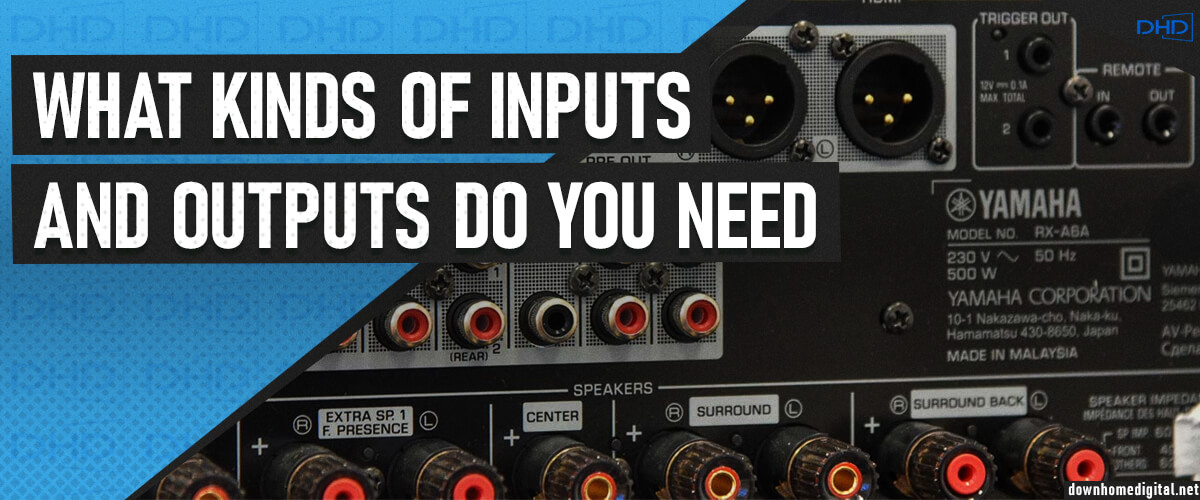
There is a standard set of inputs and outputs every receiver should have. Primarily, check whether the model you like has HDMI ports (on the front and rear panels). They are needed for pairing a receiver with a TV, Blu-ray player, etc. Though getting a unit with too many HDMI inputs and outputs, you need to pay extra, such expenses will be fully justified in the future when you’ll need to connect newly released gadgets. If you plan to watch 4K content, your receiver must be HDMI 2.0 or HDCP 2.2-certificated.
To connect audio streaming equipment (DVD and CD players, MP3 sources, etc.), you need to use audio inputs. They can be of 2 types – digital and analog. The former perfectly cope with electrical interferences and can transmit digital surround-sound formats. In case a receiver lacks digital inputs, you need to take full advantage of analog alternatives. Some users claim that these inputs aren’t as efficient as digital ones, but the difference in sound isn’t that crucial. An analog connection is necessary for attaching older CD players, analog VCRs, cassette recorders, and external radio tuners.
Fortunately, Yamaha receivers come with all inputs & outputs labeled, so getting them ready for work won’t take much time. Besides, all the labels fully correspond to buttons on the remote.
Built-in Wi-Fi, Bluetooth, and streaming services
Considering how fast wireless technologies are developing nowadays, buying a receiver without wireless support is a waste of money. The convenience Bluetooth, Wi-Fi, and streaming services have brought to our homes are difficult to overestimate, so I highly recommend purchasing Yamaha AVR with at least one of the wireless features.
This way, you can stream your favorite audio and video and different online platforms without dealing with multiple cords, which saves time and allows decluttering your space. Moreover, many receivers are supplied with bundled apps that make establishing a wireless connection as simple as ABC. What I also appreciate is the capability of powering multiple sets of speakers. That’s really cool if you have a large family and like listening to/watching different stuff. Thus, you can access Spotify and enjoy your wonderful jazz compositions while your kids on the second floor will watch their favorite cartoons.
The Yamaha brand has surpassed many competitors by developing a proprietary wireless technology embedded in many of its products. It is called MusicCast, and you can distribute the audio signal around the house, controlling the entire system through a single and convenient application, thanks to it.
4K and HDR formats
If you have read at least a couple of Yamaha receiver reviews, you’ve probably noticed that people nowadays are more thoughtful about the range of goodies a receiver can give them. That’s the main reason why many buyers are concerned about the possibility of watching 4K and HDR content. In fact, the most avid cinema-goers are already enjoying 8K movies in the comfort of their homes, but not all models can provide that yet.
While looking through different Yamaha receivers, I suggest you scrutinize the list of supported formats. Skip those units that lack 4K capability, otherwise, much action-packed content will be unavailable to you. The same goes for HDR formats which stand for High Dynamic Range and allow you to enjoy high-contrast images with vivid colors.
Dolby Atmos and DTS:X capability
Surround technologies, namely, Dolby Atmos and DTS:X, have taken a huge leap forward in recent years by making movies and TV content even more immersive.
Both technologies share the same goal – to spread the sound across a room more realistically to match the action on the screen. As a result, the cinematic effect becomes more immersive. The main difference between Dolby Atmos and DTS: X is that the latter works with standard surround sound systems without requiring ceiling speakers.
Dolby Atmos is very similar to DTS: X, but the technology itself is completely different. First off, DTS: X first appeared in home theaters, while Atmos was introduced in cinemas and then was used in home theaters, speakers, and soundbars. Atmos puts more emphasis on height. For this reason, the company recommends installing ceiling speakers for maximum sound effect.
Both technologies adhere to the standards of object-oriented surround sound, and it’s up to you to decide which option suits you most.
How I tested Yamaha receivers
I decided to give all receivers a thorough study, define their most useful features and those parameters that call for improvement. To test the movie sound, I chose Deadpool 2, which is perfect for analysis (lots of action scenes and dialog). And besides, I’m just a big fan of Ryan Reynolds’ acting talent.
To evaluate their capabilities with different music genres, I visited various streaming platforms and listened to famous songs:
- Jacky Terrasson – Reach – Tidal
- Mahler – Symphony No.2 – Spotify
- The Weeknd – The Hills – Deezer
- Led Zeppelin – Ramble On – (CD player)
- Bob Marley & The Wailers – Turn Your Lights Down Low – (CD player)
- Radiohead – The National Anthem – (CD player)
- Arctic Monkeys – Do I Wanna Know – (CD player)
- Mark Nauseef – With Space in Mind (CD player)
My go-to set of equipment consists of:
- CD player SACD 30n
- Blu-ray player Sony UBP-X700
- Speaker wire – AudioQuest Type-9
- Speakers for movie – Klipsch RP-8060FA
- Stereo speakers:
- Klipsch RP-6000F II
- KEF Q350
- DALI OBERON 5
Best Yamaha receiver reviews
Yamaha RX-A6A – best overall

The Yamaha RX-A6A from the Aventage lineup gets the winner’s cup of my rating. The series and this model have already won fans, even though the AVR wasn’t released until 2021. Usually, the premium devices with the highest price don’t win in my charts, but that’s why there are rules to break. In terms of features and quality, the RX-A6A simply has no competitors, and with the even higher-end but outdated Yamaha CX-A5200 receiver in the review (you’ll find it in the Discontinued section), it’s an optimal option for those who aren’t used to saving money. But enough lyrics.
Let me start with the receiver, who has an impressive weight of 41.2 lbs. I often mention that this figure is responsible for the quality of internal components. You don’t even need to look under the hood to realize that it uses top-notch components immediately. The RX-A6A is very beautiful, but I will never tire of saying that Yamaha made a mistake with this glossy panel because I got tired of wiping dust and my fingerprints, especially since there are no buttons on it, and you just poke directly at it. I prefer to work with gloves on, even though it’s uncomfortable. And the LCD hidden under this panel is practically invisible. But what can I say otherwise? The design is more than reliable. The double bottom has an extra fifth leg in the center front, so you don’t have to worry about resonance, which often affects the sound in budget models. Even the remote made me happy, as it’s very pleasant to the touch and works clearly and effortlessly.
The 150 watts per channel (8 ohms, 20Hz – 20kHz, 0.06% THD, 2ch) with 9 channels of amplification will make the couch beneath you shake with every movie explosion, so make sure you have a spacious room to put your home theater in. Plus, the RX-A6A can be expanded to an 11-channel system, but unfortunately only with 2 subwoofers. I would have preferred 4 subs for such a Monster. It’s a matter of taste, though, and honestly, the bass here is excellent. This is the most powerful unit on my list.
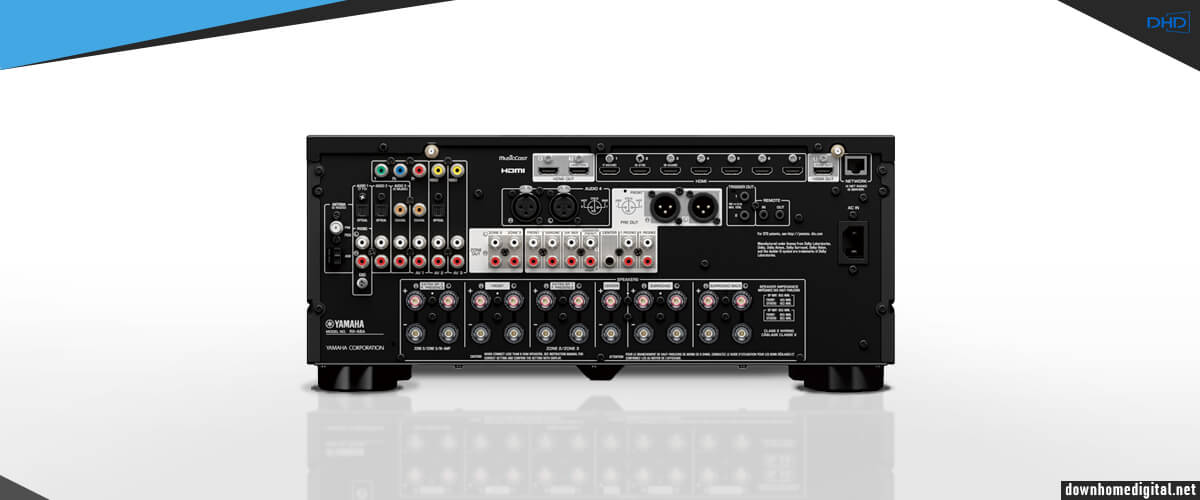
I assure you, once you decide to buy it, you will most likely not want to change it for a very long time. The next generation of sound and video technology must come for that to happen. And so far, there is no sign of that. All 7/3 HDMI ports are version 2.1, which means 8K video bandwidth, HDCP 2.3 content protection, and eARC. The RX-A6A is a truly versatile receiver because it will also suit those of you or your household who love gaming consoles. HDMI also supports ALLM, VRR, and QFT, and I’ll tell you, I literally stuck with The Witcher 3: Wild Hunt for hours. Great graphics transfer in 4K with that incredible surround sound. Delight.
I spend a lot of time with stereo testing, including wireless capabilities, especially when the AVR exceeds the mid-range category in price. The RX-A6A doesn’t have an overly diverse set of features, but everything it has works flawlessly. No, don’t get any ideas; there’s plenty of everything. There’s dual-band Wi-Fi, AirPlay 2, Bluetooth with support for SBC and AAC codecs, and built-in MusicCast, and the receiver works with voice assistants (Amazon Alexa, Google Assistant, Apple Siri). You can easily control the receiver from the app, which works great for iPhone (iPad) and Android.
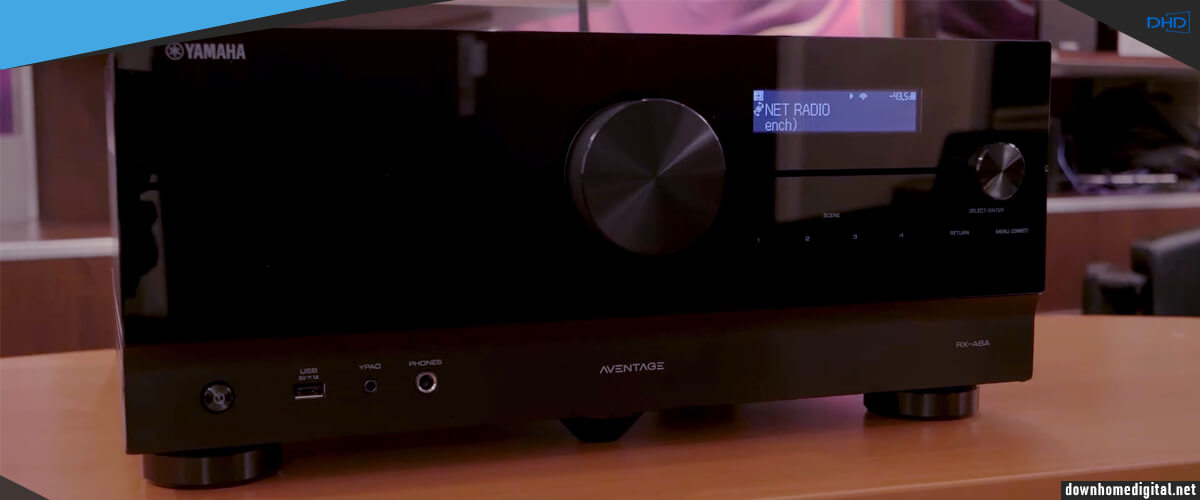
The receiver’s high-end ESS Hyperstream DAC ES9026PRO x1 ES9007S x1 DACs with 384 kHz/32-bit audio processing do the trick. I even listened to Blue Train, John Coltrane’s Album 1957, on vinyl ( there is a phono input). And I have to be honest that I don’t find the cold, clear sound of Yamaha for vinyl suitable, although I give the position to the sound quality itself. But for sax, this sound was more than appropriate.
Also, as my story progresses, it would not be out of place to mention that I was most impressed by the RX-A6A’s collaboration with a pair of Klipsch RP-6000F II floorstanders. Since the receiver has very high-quality DACs, these speakers open up to their full potential, delivering their purest sound. At the same time, the AVR’s sound gained a bit more depth and nuance than I usually lack because of the crystal clarity. All in all, you could say that they responded well to each other. I recommend bi-amping.
That leaves the main part; we are talking about a multi-channel receiver, after all – surround sound. The three most popular immersive formats, Dolby Atmos, DTS:X, and Auro-3D, as well as mixing and virtualization formats, are available to you with this unit. The only thing missing is IMAX Enhanced, but the company’s CINEMA DSP HD3 makes up for it. I turned on sports broadcasts and concert recordings, and I can say that my team was thrilled with what they heard. In a fairly large studio, being in a stadium (or concert hall) feels quite realistic. Still, it does have Surround:AI technology, which analyzes the soundtrack in real-time and independently adapts it for the viewer. That’s something you won’t find in the brand’s low-cost lineup.
While watching the RX-A6A Star Wars: The Rise of Skywalker, every lightsaber thrust, every step, turn, sigh, or cue resonated within me, making me watch and listen more and more intently (and I’m not talking about the story itself, of course). It’s just a buzz for the ears, especially for such an epic movie with various scenes. When another spacecraft took off, you wanted to cover your face with your hand to keep the dust and small rocks out, honestly.
The Yamaha RX-A6A is the best Yamaha receiver in my rating. It has everything a modern consumer needs: 8K video, features for a game console, phono input for a vinyl player, wireless options of various types, iOS and Android compatibility, and, of course, the most popular surround sound formats. Oh, and it should be noted that you have a multi-room for 4 zones. So, if you want to buy a receiver for a diverse family and distribute channels to as many rooms as possible, this is your choice.
This is the most powerful AVR of my chart, and it sounds great and flawlessly clear even at maximum volume. And all its flaws are so minor that they’re not worth mentioning. The RX-A6A is made for those not used to skimping on equipment, letting it serve as long as possible.
| Power |
|
| HDMI features |
|
| Video features |
|
| Network |
|
| Surround sound processing |
|
Pros
- A very heavy, anti-resonance reinforced cabinet.
- With the help of an external amplifier, the system can be expanded up to 11 channels.
- The most powerful receiver of the rating (150 watts per channel).
- Supports all of today’s most popular surround sound formats.
- CINEMA DSP HD3 technology creates the feeling of being in a stadium or concert hall.
- Surround:AI analyzes the space, adapting the soundstage in real-time.
- Multi-room for 4 zones.
Cons
- The LCD is virtually invisible.
- Only 2 subwoofers can be connected.
YAMAHA RX-A4A – also a great choice
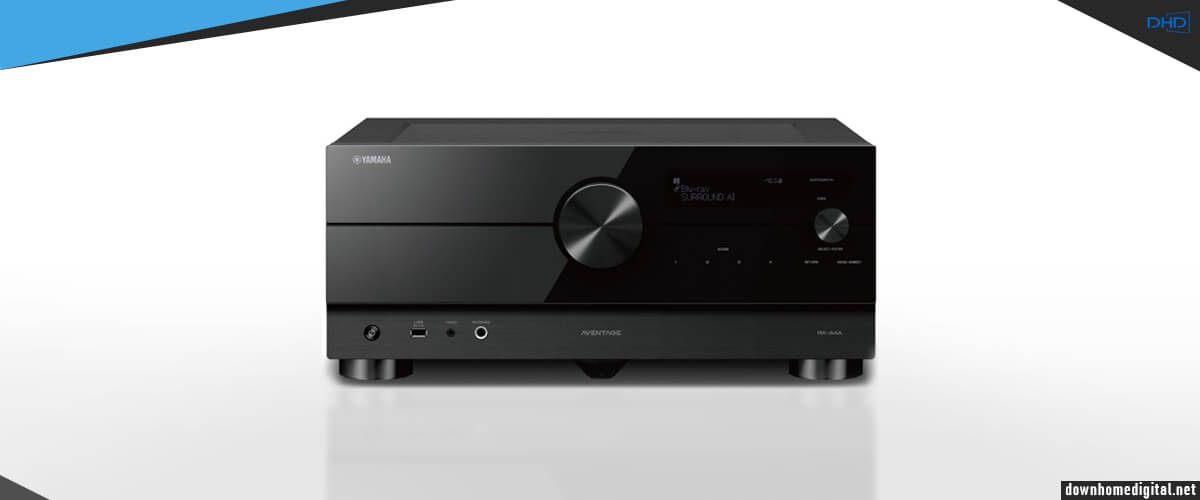
The Yamaha RX-A4A is also part of the Aventage lineup, but it’s downgraded. To start with, it’s a 7.2-channel receiver that has fewer options and 100 watts of power (8 Ohms, 20Hz-20kHz, 0.06% THD, 2ch). It can also be a great choice if you prefer smaller systems, as its features are largely identical to the RX-A6A, but it’s not hard to guess that its price is lower. In fact, it’s almost twice the price.
Externally, the receiver is similar to the leader of the selection but doesn’t have additional chips for anti-resonance. Although with a weight like this (35.7 lbs), it’s not such a problem. It’s still a quality-heavy unit, which makes it very different from most 7-channel receivers from other brands. Otherwise, all the shortcomings (important to me) I described above are here. However, given the ability to control it from an app or by voice, you can set it up once and then only have to wipe the dust off when it bothers you (or maybe you’re not a cleaner than me at all?). The volume control’s sensitivity has also been retained; I really like the smoothness of it. But note that the front panel contains touch controls. So, when you turn the smaller wheel, you can accidentally activate one of the pre-programmed inputs.
It has multiple HDMI inputs and outputs (7 in / 3 out) that support the latest HDMI technology as much as the RX-A6A. You can enjoy movies and games in higher resolution for a more realistic watching experience. While Yamaha RX-V6A has nearly the same capabilities, it has fewer HDMI outs, which may make RX-A4A a more appealing solution when the number of HDMI outputs is essential for your applications.
This receiver has a few prominent features worth mentioning here. Let’s start with my favorite one – artificial intelligence technology. It’s amazing how it analyzes the scene of the contents and fine-tunes the surround effect according to the background music, dialogs, and sound effects. It determines the optimal distribution of voice and instrumentation to the speakers, which I love a lot. However, I am not that enthusiastic about how it works with older audio content. It pushes too much of the voice to the center speaker, which makes listening to the music of the 60s and 70s slightly odd.
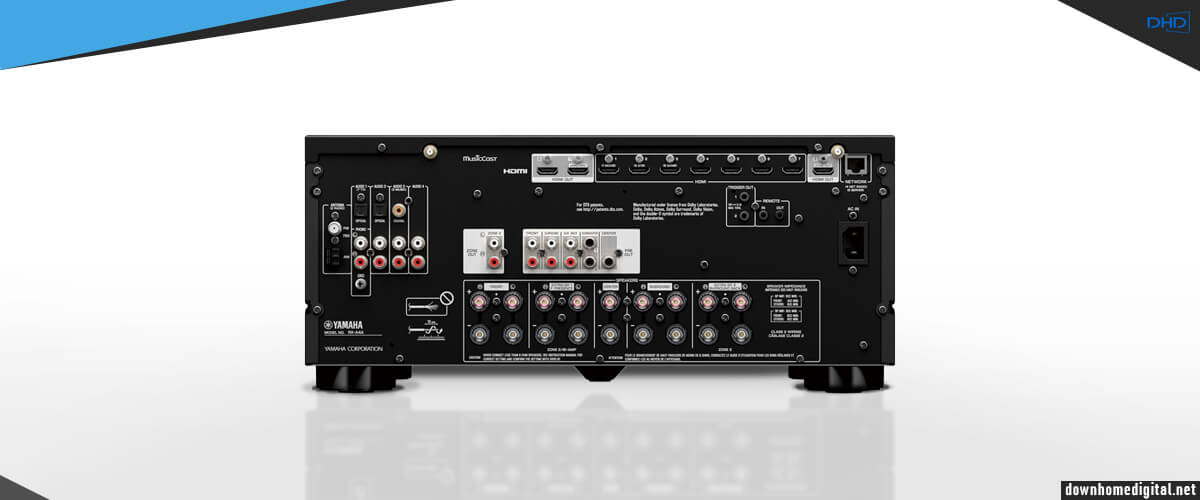
I find the MusicCast feature a gem. I stream Spotify, Qobuz, and Amazon Music with ease. At this point, YAMAHA RX-A4A makes listening and discovering tracks much easier. And with the voice control feature, it’s really a breeze to control the entire whole-of-home system.
The receiver’s YPAO calibration system is not the most advanced (it loses to other brands, and I’m still waiting for Yamaha to fix this shortcoming finally). And this applies to all models. But I was very satisfied with the sound quality of this receiver. Exactly on the level, not on the overall soundstage, it is practically not inferior to the leader of the selection. But, of course, the stage is more stingy due to the smaller number of channels.
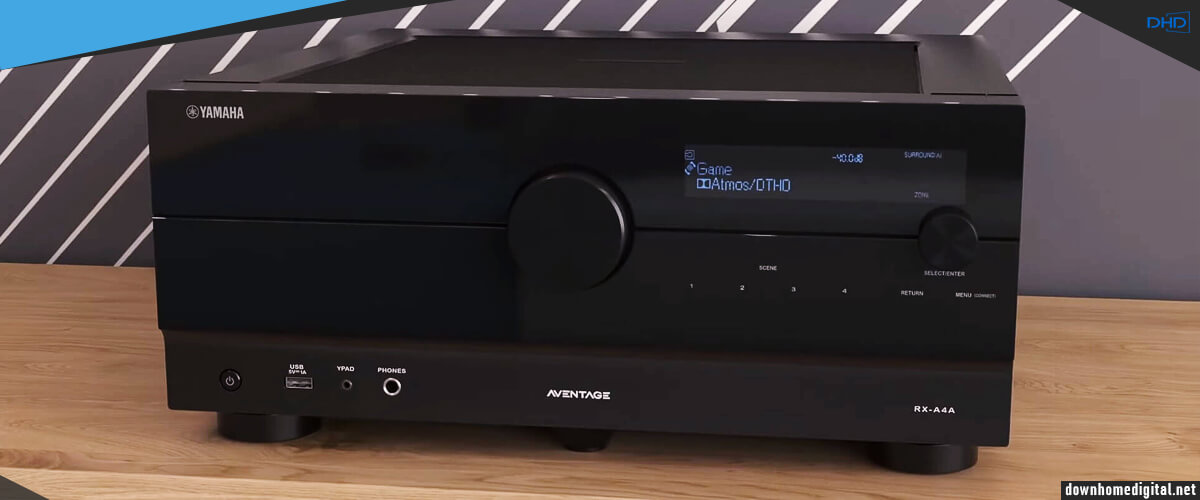
Nevertheless, with the RX-A4A, you will hear all the details of any movie in Dolby Atmos or DTS:X. I specifically turned on Transformers, as it has many of the metal sounds that Yamaha is so suited to. Few devices of this rank do this well, but I was pleased with what I heard. Great dynamics and dispersion. But we should not forget that this model is more expensive than many 7-channel devices, which belong more to the budget class. In this case, we have a confident average.
RX-A4A is actually a simplified version of Yamaha RX-A6A and rightfully takes the second place in the rating. It is inferior to the leader in the number of channels (7), power (110 W), the number of multi-room zones (2), and the absence of the Auro 3D surround sound format. Sound quality, menu interface, ease of setup, reliability of internal components, even the identical DAC – the manufacturer preserves all this with careful trepidation.
So, if your room is around 300 square feet, you shouldn’t dream of more unless you want to separate the seating area from the rest of the household. This is a very good choice at a nice price and with great modern functionality.
| Power |
|
| HDMI features |
|
| Video features |
|
| Network |
|
| Surround sound processing |
|
Pros
- AI distributes sound effects and voice smoothly for a better experience.
- Flawlessly streams music from Spotify, Qobuz, and Amazon Music.
- Has many HDMI inputs and outputs, as much as the RX-A6A.
- Voice control makes controlling the sound system a breeze.
Cons
- AI surround technology doesn’t work properly for older content.
- Touch controls on the panel can be easily triggered.
- YPAO’s calibration system loses out to other brands.
Yamaha RX-V385 – budget
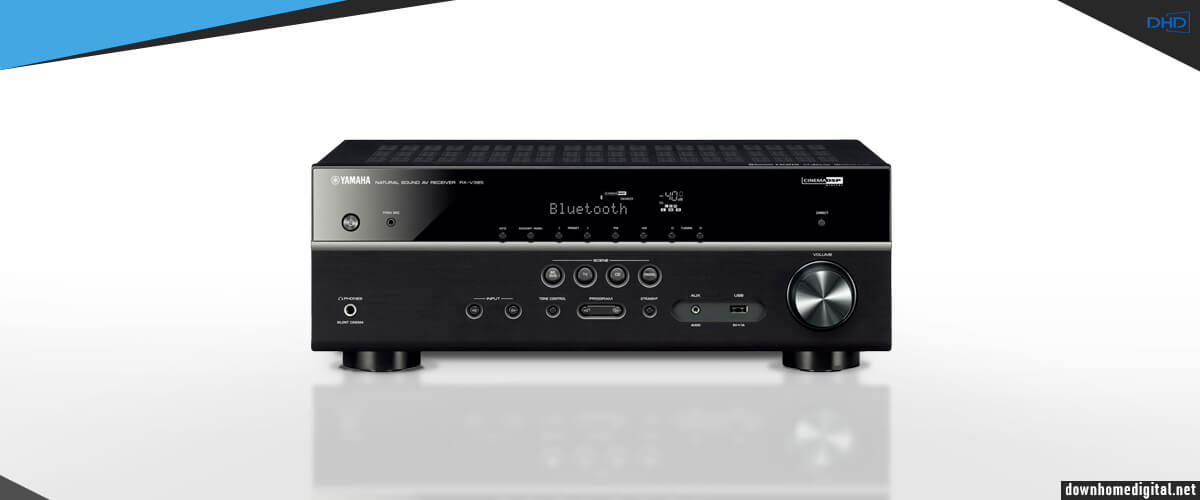
RX-V385 is a representative of the budget segment of the Yamaha lineup. Its price is so low that I’m ashamed even to look for flaws in it, to be honest. But it has them, as well as advantages. And I’ll start with the fact that this device has 5 amplification channels and a power of 70 W (8 Ohms, 20Hz-20kHz, 0.09% THD, 2ch). That is, it is the simplest and lowest-powered system in my rating.
The first thing I noticed is that the design, size, and external layout of the control buttons have not changed compared to the previous generations of Yamaha RX-series receivers. This is great for loyal users of the brand, as it won’t take long to get used to this model. Yamaha RX-V385 is an entry-level device, so the lower front panel is made of plastic, while in the top-tier models, e.g., Yamaha CX-A5200, it is made of metal. The connectors are too close to each other, there are no dedicated input buttons, and the control buttons give out characteristic clicks when pressed. If I were you, I would prefer the remote control, which is also quite simple.
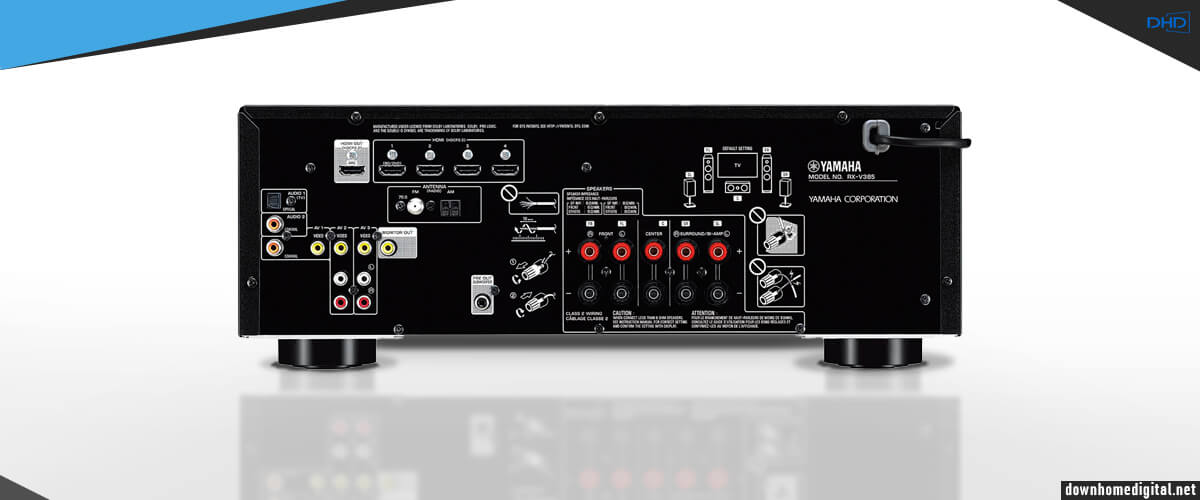
The on-screen menu of the receiver is straightforward, so it’s easy to grasp what is what. A quick start guide is also very helpful. Supported USB formats include MP3, WMA, MPEG-4 AAC, WAV. Based on my experience, listening to music through the USB port isn’t interesting because of its few functions and a meager interface. Any modern media player with direct audio output via HDMI can cover the missing audio formats and resolutions. By the way, the RX series is intended more for watching films than for listening to high-quality audio file formats, so the RX-V385 is a great option in this regard.
As for wireless connections, there is only Bluetooth here. Built-in Wi-Fi is available in a higher price category. Anyway, I like that Yamaha added at least 1 wireless connection technology to this entry-level 5.1 receiver. An ECO mode allows you to reduce power consumption, and you can also configure a standby mode.
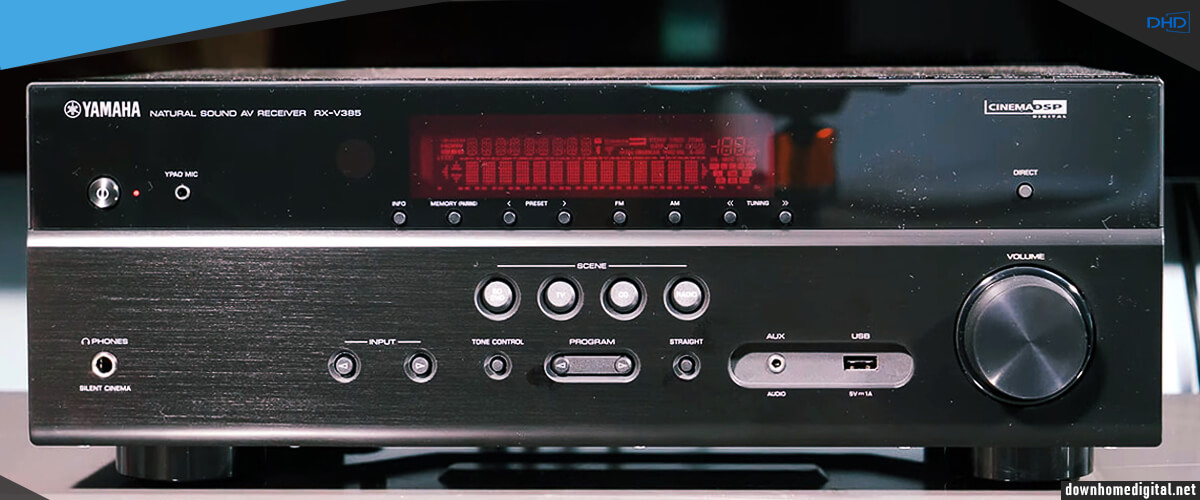
The sound in surround formats is traditionally detailed, large-scale, and clear. But you understand that we are not talking about high-rise channels here; we are dealing with basic channels. There are many presets for movies and music. If you don’t like them, you can alter the sound using a seven-band equalizer with separate adjustments of high and low frequencies, but they barely change the sound when you adjust any of them from -6 to +6. I tried the YPAO mic, and the setup process ran smoothly. This is a convenient feature for first-time users.
I sometimes talk about what speakers can bring out the potential of a receiver. Regarding the RX-V385, I can confidently say that the inexpensive (but very nice) Q Acoustics 3020i shelf speakers didn’t just emphasize or enhance the stereo sound. Still, it felt like they were designed to allow the receiver to stream music at all. Honestly, these babies are as good as any others in their price segment; I didn’t even plug in a subwoofer, so well, they did the job. Don’t think they sound tower level, but I’m talking specifically about the combination in the system. A great budget option.
The RX-V385 is a great budget Yamaha AV receiver for those users who settle for a simple, no-frills device. Perhaps you have a small apartment or want to buy it for a teenager in a separate room or install it in a workshop. The 5-channel receiver copes well with its main task – creating three-dimensional sound for movies and transmitting video signals with 4K resolution. With properly selected acoustics, you can also listen to music. In any case, it’s better than through any boom box.
But, of course, it loses to the rest of the rating participants in almost everything. It doesn’t even have WI-FI, and Bluetooth supports only the SBC codec. And while the receiver is easy to operate, it also lacks most settings. I’d recommend the slightly more expensive 7-channel Yamaha RX-V6A if you asked me.
| Power |
|
| HDMI features |
|
| Video features |
|
| Network |
|
| Surround sound processing |
|
Pros
- Instant setup using on-screen menus.
- Numerous settings to configure core parameters.
Cons
- The lowest power rating, 70 watts.
- The buttons make a clicking sound when pressed.
- Connections are located too close to each other.
- No dedicated input buttons.
- The treble and bass controls barely alter the sound when adjusting either one from -6 to +6.
- More suited for movies than music.
- No Wi-Fi.
- Bluetooth only supports SBC codec.
Yamaha R-N303 – stereo
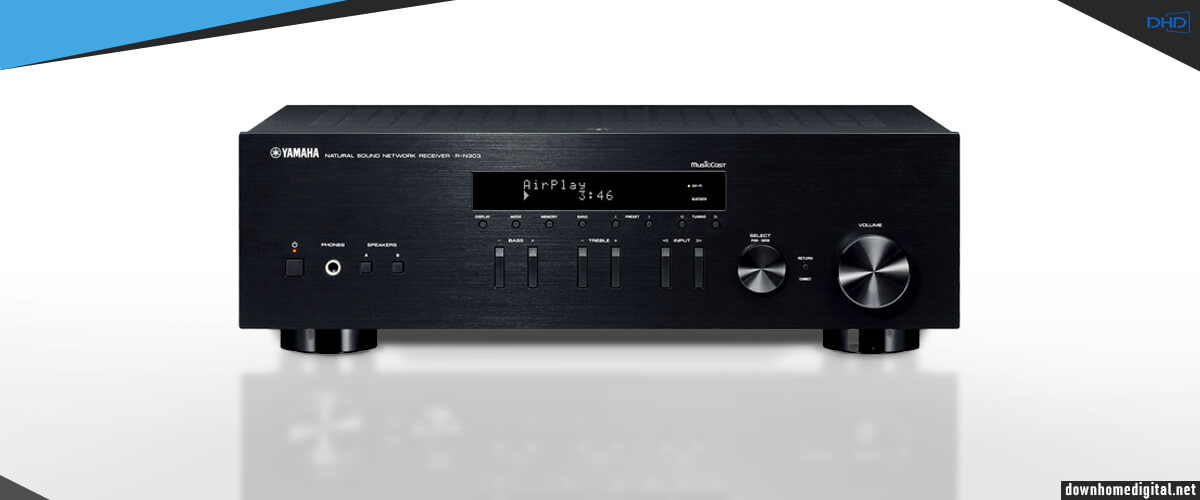
If you are not interested in surround sound in movies but want to listen to music, not just with a portable speaker, I suggest you pay attention to the Yamaha R-N303 stereo receiver. Quite powerful, with many features, it is not a high-end device, but among other brands, it stands out in a good way.
The R-N303 looks pretty nice, but that is until you touch it. The thin metal flexes under your fingers, and I almost dented it while installing it. The LCD is small, but you can see everything well. But like many budget receivers, the bass and treble controls are adjusted by buttons. But there is a default volume setting, so you don’t have to plug your ears when turning it on (I often encounter this with other brands). Flipping the Yamaha R-N303 over the other side, you’ll only find jacks for two pairs of speakers, optical, coaxial digital, and an Ethernet input. Oh, that’s right, there’s a radio tuner. In general, everything is simple, which can be regarded as both a minus and a plus.
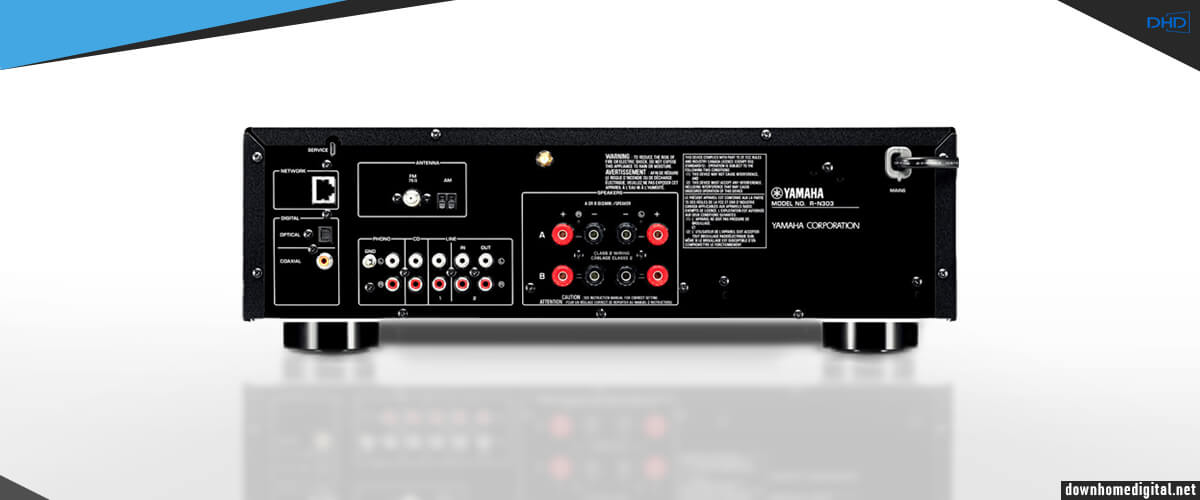
Thanks to the proprietary MusicCast protocol embedded in this receiver, you can connect up to nine compatible devices via Wi-Fi, Bluetooth, or AirPlay. Besides, you can stream wireless audio in different rooms, making this unit ideal for multi-purpose use. I really appreciate instant access to the most popular streaming services, including Spotify, Deezer, etc. So, those looking for a genuine 2-channel Yamaha stereo receiver will be blown away by the capabilities of this model. But compromises are inevitable, and I’ve seen Bluetooth and Wi-Fi connectivity drop a few times. And “works with Alexa” means that Alexa will just turn on the receiver and execute no other commands. Too bad, I don’t like such surprises.
If you want to enjoy the power of MusicCast technology to the fullest, install a bundled app and use it to control the playback by tapping and swiping. Its installation is free of charge. What can be easier? Another feature that deserves a special note in this review is support for high-res formats. If this is something you are looking for, opt for Yamaha R-N303. It outputs 100W with 8 Ohm speakers, so just get a decent assembly.
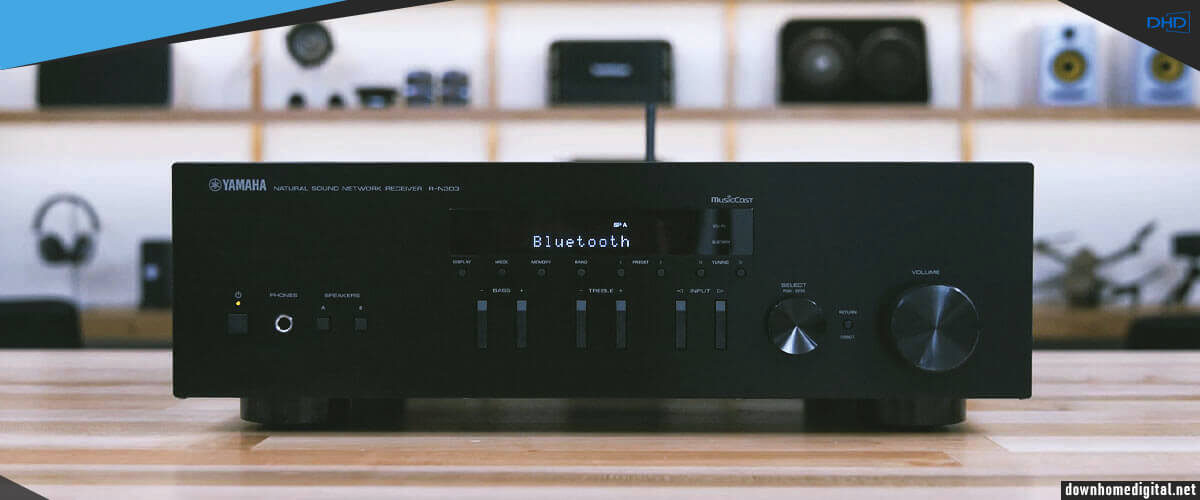
While testing the model, I heard a nicely powerful bass and enough delicacy and rhythm with other music genres. If you pair this model with high-sensitivity speakers, you will be rewarded with true Hi-Fi sound. Those crazy about vinyl sounding can get the most out of this receiver by connecting a turntable via a phono input. Of course, this is possible because Yamaha R-N303 is initially designed with audiophile requirements in mind, so when choosing other models from this review, e.g., Yamaha RX-V685, you won’t be able to relish your vinyl collection.
If you like listening to different music genres, this model has much to brag about. When you use the receiver at full blast, it will amaze you with pulsating basses. If you want something quieter with hushed halftones, it can also perfectly cope with this task. Those users, who are mainly interested in plaintive music, can also rely on this device.
On the whole, this is the only stereo audio receiver I decided to present in this review because it has collected the most praise-worthy features of similar units from the brand without tiring users with complicated controls. If you are mainly interested in playing music and don’t want to drain your budget, this is a wonderful option to buy.
Nevertheless, you should realize that a receiver of this rank will never achieve sound at the level of professional amplifiers. And it is always better to use an external preamplifier for your turntable. But that’s the beauty of the Yamaha R-N303 – it is a two-channel device for a music lover with low demands.
| Power |
|
| HDMI features |
|
| Video features |
|
| Network |
|
| Surround sound processing |
|
Pros
- Comes with free, non-subscription MusicCast app for controlling the playback.
- Quick access to iTunes library and playlists.
- Allows setting a default startup volume level.
- Separate bass and treble controls.
Cons
- The case is made of thin metal.
- Push-button bass and treble controls.
- Bluetooth and Wi-Fi connection drops sometimes.
- “Works with Alexa” just means Alexa will turn the receiver on.
Yamaha RX-V6A
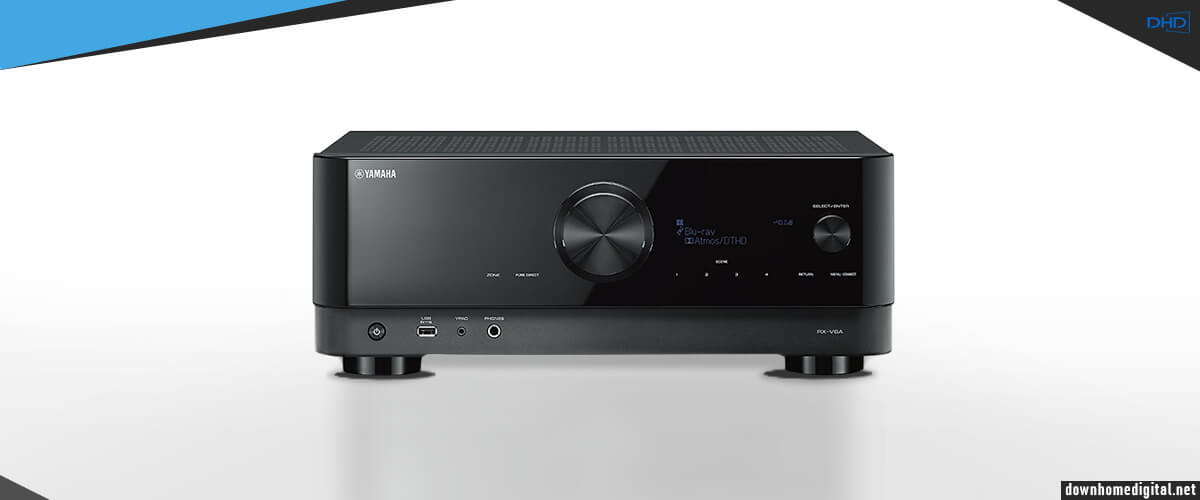
Yamaha RX-V6A will be an alternative for those who want a 7-channel home theater system but are not ready to spend a tidy sum to buy Yamaha RX-A4A. It falls slightly short of the second spot on my chart, but its power is not among the compromises. The receiver offers 100 watts per channel (8 ohms, 20 Hz to 20 kHz, 0.06% THD, 2ch), so you don’t lose out on either volume or clarity.
Do I need to explain again that the more weight, the better the receiver’s innards? I don’t think so. I’ll just compare the 21.6 lbs of the model in question to the 35.7 lbs of the RX-A4A. Know that those 14 lbs have robbed you of parts that could provide you with quality sound for a long time. So, it’s likely that over time, the RX-V6A will begin to produce distortion. What follows is a bit of a carbon copy. No, the devices are not like twins, but there is also the gloss I hate. The panel is even more fragile because it is made of thin plastic. Invisible LCD and touch buttons under a small wheel. Add the not-so-smooth volume rotation to that, and you can see why you’re paying less.
When I got down to the first setup, I decided to try the AV Setup Guide app, and it worked even better than I expected. In addition to standard settings, it helped me connect speakers, CD, and Blu-ray players.
I installed the MusicCast CONTROLLER app on my smartphone to control this AV receiver without hassle. In fact, this app also worked as a remote control, so finding the proper settings and initiating audio playback was a breeze.
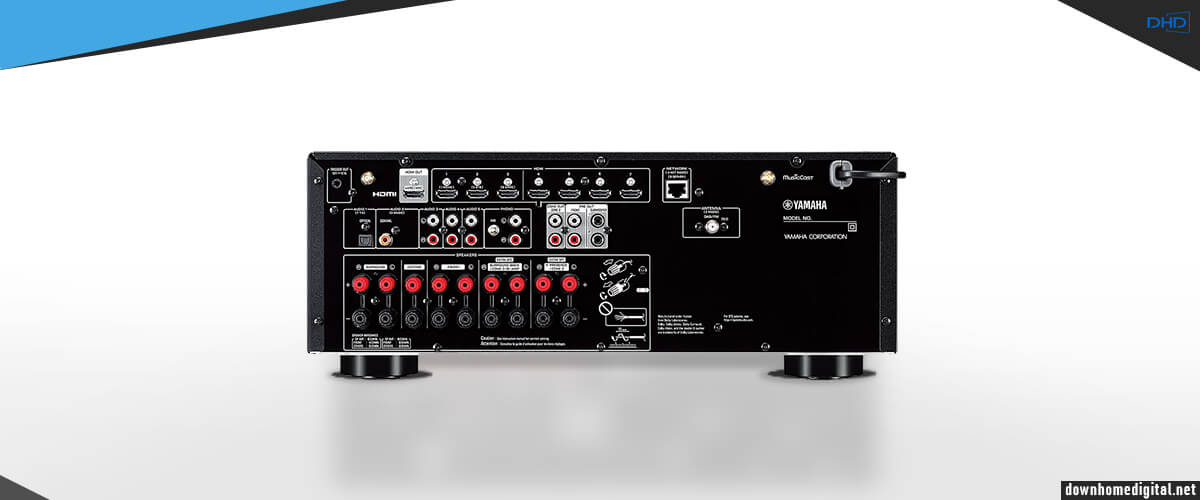
If there are no ceiling speakers in your room and you don’t feel like redesigning your setup, you can still get better sound with a Dolby Atmos Height Virtualization. Another interesting feature of this 7-channel device is DTS:X immersive audio formatting technology, which distributes audio in a logical way, so it seems that action depicted on the screen actually happens in your house. While testing the video, it felt like Deadpool was fighting opponents right in my room. Awesome feelings! But the current audio codec is not shown on the display.
Yamaha RX-V6A can transmit HDR10 + signal, which covers not only the high dynamic range but also includes a small amount of metadata with scene characteristics between dark and light. Typically, this feature is available in premium devices (for instance, Yamaha CX-A5200), but it is also perfectly realized in this unit.

Before listening to music from TIDAL, Spotify, and other platforms, I run YPAO to analyze the acoustics of my studio and the entire system. The entire process was quite swift, and all sound parameters were on point, so I got crisp and detailed sound. Most of all, I like that there appear no ear-splitting sounds no matter how high you raise the volume. So, even if you listen to rock compositions, you won’t hear rowdy and brassy noise.
This system is equipped with compatible Zone2 speaker jacks and can send the audio and video content played in the main room to another room (or play 2 different kinds of video/audio). There is also a dedicated phono input for connecting a turntable. I tested this capability and can say that there were no severe differences between audio in 2 rooms.
So, the Yamaha RX-V6A is quite a decent device with 8K signal transmission, Dolby Atmos surround sound, and wireless music listening features. It has a very good sound, especially considering the price point. It has an ergonomic, elegant design and simple operation, and it meets the demands of the modern user.
But let’s be honest. Do you pay half as much as you would for the 7-channel RX-A4A and expect to get the same thing? No, and no again. Even the receiver’s construction is unreliable, indicating that it belongs in the budget class. The lighter weight suggests that the construction is based on cheap components, which guarantees that the receiver will lose the clarity and quality of the initially quite good sound after some time.
It’s your choice, but I prefer quality, even if it’s a small system. And if you appreciate the cold, crystalline, clear sound of Yamaha and want to save money but get equipment that will serve you for decades, look at Yamaha RX-A4A.
| Power |
|
| HDMI features |
|
| Video features |
|
| Network |
|
| Surround sound processing |
|
Pros
- Similar in its parameters to the more expensive Yamaha RX-A4A.
Cons
- Over time, the unit may sag in sound as the internal components are not as high quality as the RX-A4A.
- Doesn’t show the current sound codec on the display.
- Fragile plastic panel and loose knobs.
- The volume button doesn’t rotate smoothly.
Discontinued models
Time is ruthless to technological advancement. The equipment at the peak of popularity yesterday may not be current today. Nevertheless, there are models of receivers that, thanks to internal components, implemented technologies, and, most importantly, sound quality, may well be able to outshine more modern devices. Sometimes, manufacturers add more features to new products, sacrificing exactly the quality of chips, processors, or DACs. I advise you to closely examine two very good models that are still available today at a reduced price.
Yamaha CX-A5200
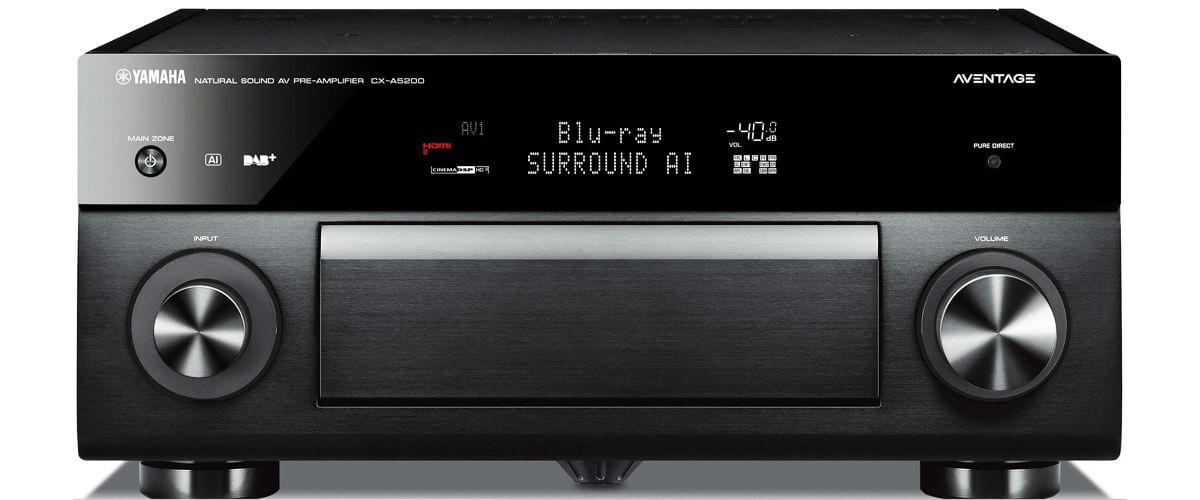
The 2018 CX-A5200 was a superb next-generation device at the time of its release. But time is of the essence, and technology becomes obsolete too quickly. In terms of hardware, it’s still a high-end device. Suppose you appreciate the factors that affect sound and understand that sometimes you can sacrifice more modern features in favor of high-end internal components. In that case, I suggest looking closely at this receiver.
The receiver is fitted with a special component that analyzes audio signal characteristics in real-time and adjusts it according to the current surrounding for better sound output. The unit offers automatic handling of the dynamic range, dialogue, sound effects, background music, and channel balance. That’s why the manufacturer states that this model improves dialogues in movies immensely and creates a full-fledged sound even in scenes with a serious musical load. Actually, this is true because I perfectly heard dialogues while watching the movie, and there was no muffled sound.
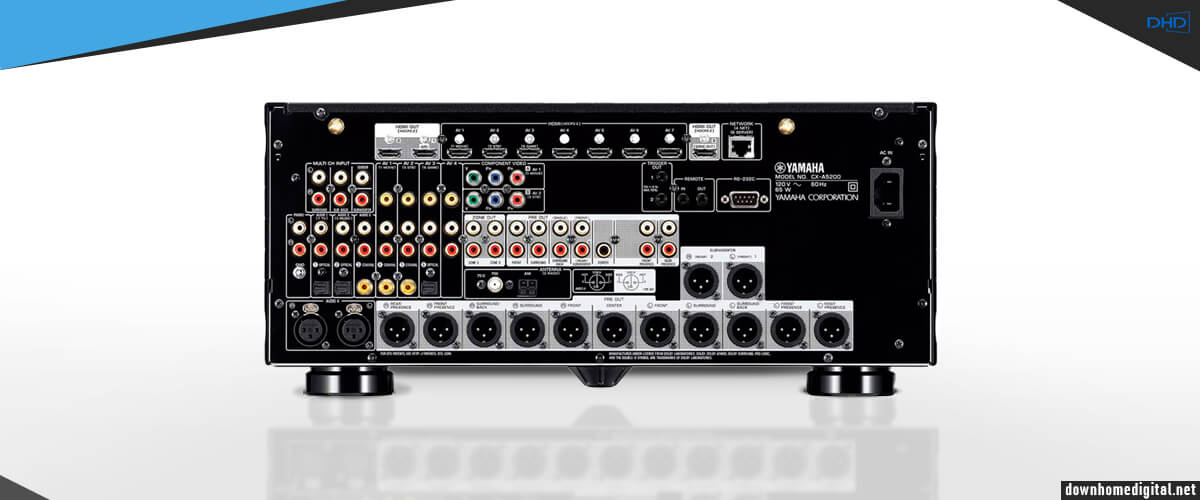
Like Yamaha RX-V685, this 11-channel receiver supports the Amazon Alexa voice assistant, but the “communication” here is executed more efficiently as the CX-A5200 belongs to the AVENTAGE niche of AVRs. I used the features of Amazon Alexa when I wanted to switch audio tracks to evaluate how well the receiver copes with fast- and slow-paced audio. I am delighted with what I heard. Bass was powerful, and there was also a defined balance between low and high frequencies.
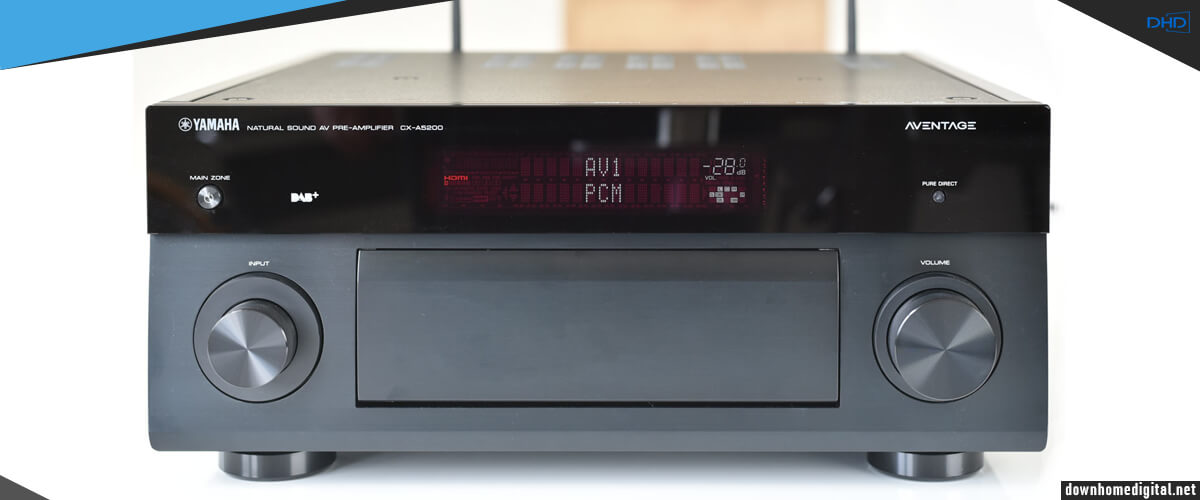
You can use seven HDMI inputs with HDCP 2.2 and three HDMI outputs. The receiver recognizes BT.2020 palette, three HDR formats (HDR10, Dolby Vision, HLG), Dolby Vision, and DTS: X surround audio formats. Other handy features are YPAO, which adjusts the sound to a specific room, and RSC responsible for controlling sound reflections. Both technologies work lag-free, and I got rhythmic sound in my studio during the test.
All in all, this is the best premium Yamaha home theater receiver that easily withstands severe rivalry with other brands. Here you get all the major features, as well as numerous add-ons for enjoyable pastime activity. Either you like holding movie nights or want to listen to audio in high quality, this model is sure to satisfy your needs.
| Power |
|
| HDMI features |
|
| Video features |
|
| Network |
|
| Surround sound processing |
|
Pros
- Deep sound and clear dialogues in movies.
- Support AM/FM HD radio.
- Allows streaming music via Bluetooth.
- Capable of passing HDR10+ through.
Cons
- Not IMAX Enhanced.
- Unintuitive remote.
Yamaha RX-V685
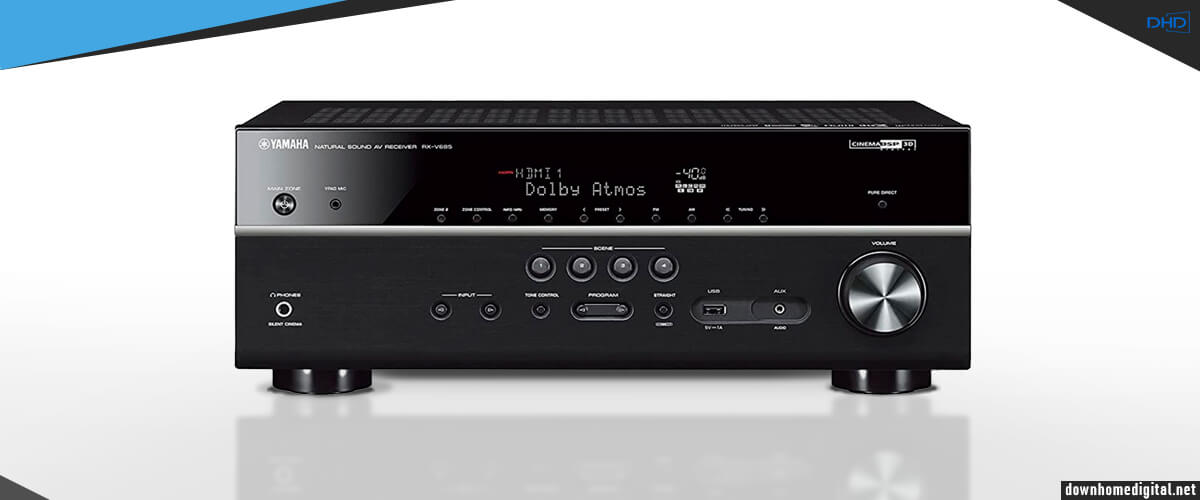
The manufacturer created a potent receiver, so I spent quite a lot of time testing all available features. The most notable peculiarity of this unit is proprietary MusicCast technology that guarantees amazing sound quality both during music playback and while watching videos. I like the possibility of further upgrading the system incorporating other MusicCast-enabled devices to achieve crisp audio across the entire space.
The receiver is a perfect fit for a 7-channel home theater system when the main accent is evenly spread surround sound. That’s actually what I got while watching the movie and listening to music in my studio. The declared power output is 90 watts per 8 Ohm channel, which is enough for medium-sized rooms.
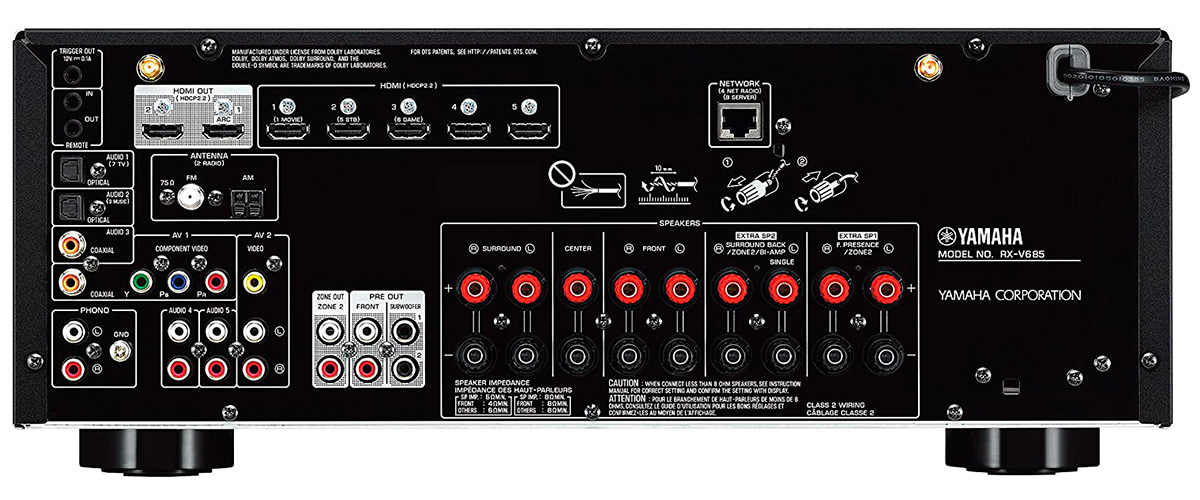
I like that Yamaha RX-V685 supports the newest HDMI standards, so if you want to watch 4K content in good quality, it is a decent option to try. Though Yamaha CX-A5200 offers the same capabilities, the difference in the cost may be a decisive point for some users.
Other vital technologies integrated into the model to satisfy users are HDR, Dolby Vision, and Hybrid Log-Gamma. They fix contrast issues, make tones smooth, and boost the color gamut. In fact, thanks to a wider color range support, you always get true-to-life visuals.
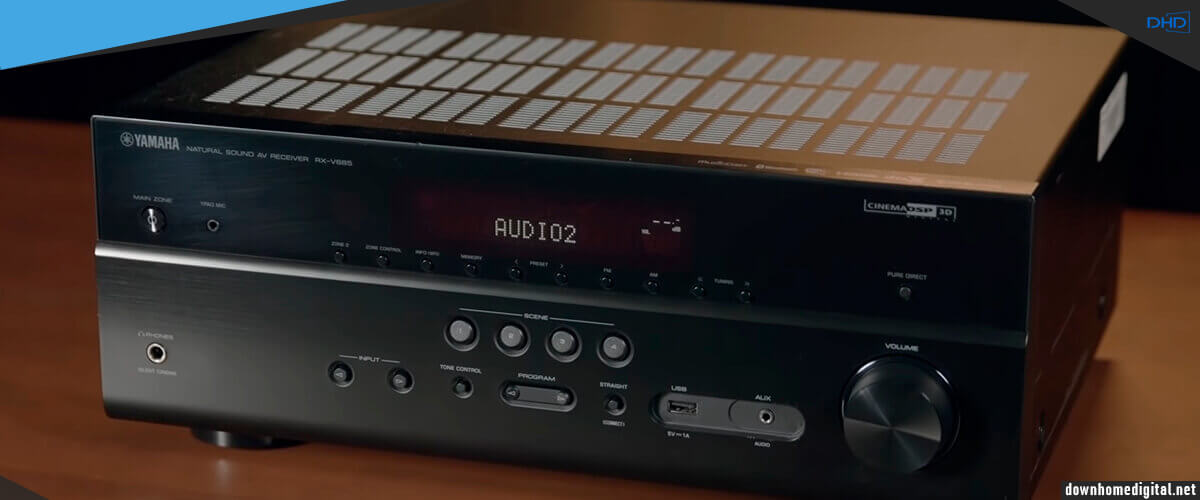
In addition to wired connections, you can take advantage of Wi-Fi, Bluetooth, AirPlay, and Spotify Connect, so streaming audio from mobile devices is a quick operation. I tested all options and encountered problems only when using Spotify Connect. However, that isn’t a crucial defect. As for voice controls, Alexa works without lags.
Considering its budget-friendly price and the range of features stored on-board, I can confidently call the RX-V685 one of the best Yamaha receiver. The integrated MusicCast technology significantly improves output audio quality, allowing you to create a pretty modern home theater system without going bankrupt.
| Power |
|
| HDMI features |
|
| Video features |
|
| Network |
|
| Surround sound processing |
|
Pros
- EQ with adjustable center frequency and Q factor.
- Compressed Music Enhancer improves all music genres and expands the dynamic range.
- 4K, Dolby Vision, and HDR10 support.
- All settings can be customized to your liking.
Cons
- Buggy firmware.
- May lag when working with Spotify Connect.
- Inputs aren’t labeled.
Buyer’s guide
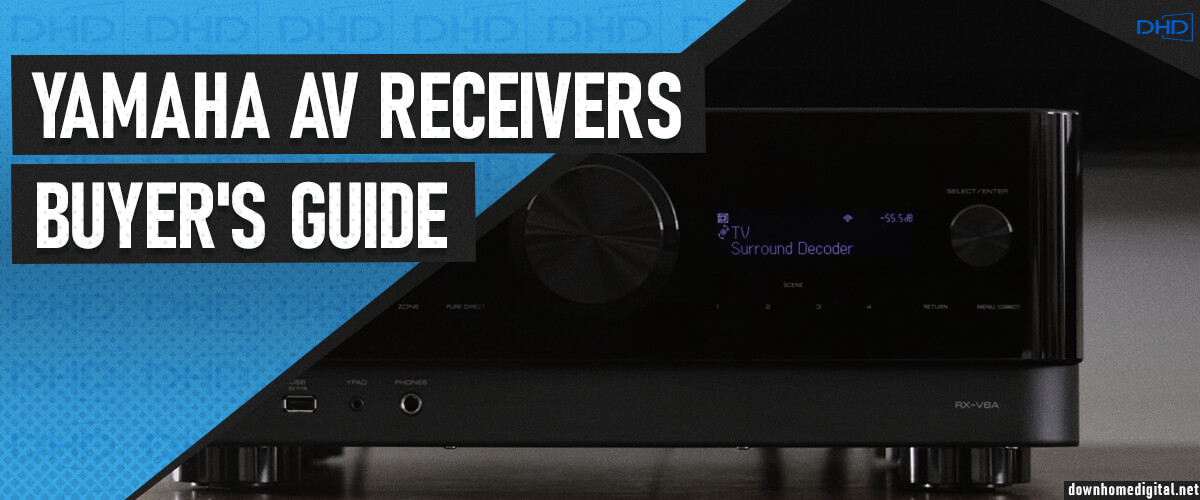
Do I need multi room capability
Top AV receivers from Yamaha brag about the possibility of delivering sound to several “zones” at once. Though this seems like a mind-blowing feature, sometimes it is a well-thought-out bait for inexperienced users. When we are talking about powering several rooms from a single receiver simultaneously, we actually mean that two or more channels typically involved in outputting surround sound will be dealing with another task.
For instance, you may watch a comedy in one room, and your wife will watch her favorite TV show in the neighboring room. Great? Not real. In this case, the overall power of your receiver will be divided into 2, so neither you nor your wife will enjoy a genuine surround sound.
The thing is slightly different if you complement your receiver with a third-party amplifier. Thus, it will be fully responsible for managing the second zone without drastically degrading the sound quality.
In fact, you can derive the biggest benefit of multi-room capability if you own a 7.1-channel multi-zone receiver with built-in streaming services. Thus, your device is initially optimized for such work, so you’ll get awesome sound in both places.
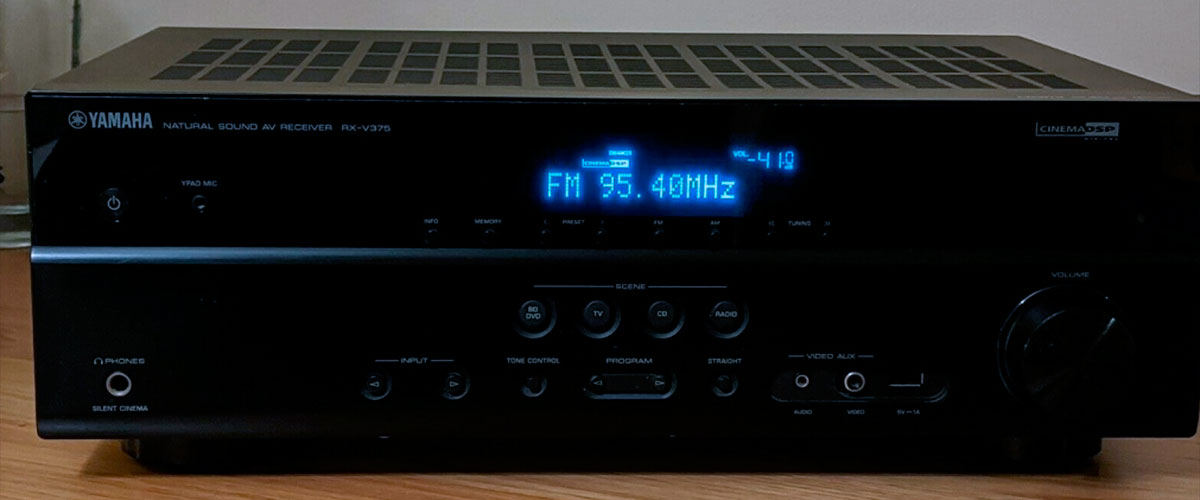
MusicCast wireless surround sound by Yamaha
MusicCast multi-room wireless technology by Yamaha delivers full and deep sound in large spaces. It allows you to combine multiple audio devices in a quick way without using wires. The system is easy to operate thanks to the MusicCast CONTROLLER app. Depending on the combination of devices and settings, MusicCast Surround technology creates a true surround sound effect.
What is the difference between MusicCast and other similar technologies?
Quality. Products equipped with MusicCast technology deliver high-definition audio and ensure smooth music playback in all rooms.
Functionality. MusicCast devices support several wireless connection methods. HDMI connectors available in many receivers are designed to connect additional audio sources to a receiver without using third-party adapters.
Configuration and control. To create a multi-room system, you need a router, a MusicCast-enabled device (e.g., a receiver), and the free Yamaha MusicCast CONTROLLER app.
MusicCast CONTROLLER app. Install this application on your device, control the sound across the apartment/house, and distribute it to speakers and other devices. A user-friendly interface allows you to select the sound location, signal source, and composition. All adjustments are performed in several taps. Most audio systems operate in the 2.4 and 5 GHz Wi-Fi bands. Therefore, t set an Internet connection, you don’t need to use adapters. However, it is advisable to add repeaters to the setup to boost the signal strength and expand the coverage area.
Popular models of audio systems
You can enjoy the convenience and flexibility of the technology with modern MusicCast 20 and MusicCast 50 speaker systems.
MusicCast 20. The speaker system is absolutely easy to connect and use. It allows sharing audio content across your home, offers built-in music services, Alexa voice assistant, has an ultra-simple interface for instant audio playback. In fact, it has everything you need to ensure comfort while listening to audio.
MusicCast 50. With the MusicCast 50 speaker system, you no longer need to arrange cables in your home. A wireless connection makes it easy to establish “communication” between individual components of the system. Despite its compactness, the device provides large-scale, high-quality stereo sound. Control is carried out from a mobile gadget using the MusicCast CONTROLLER application. The Alexa voice assistant is also available for instant playback control.
Yamaha has introduced a really revolutionary approach to music playback, embedding MusicCast in their devices. While selecting the best Yamaha receiver, you are sure to bump into models supporting this technology. Though it raises the price, the benefits it brings to your media consumption sessions are totally worth the cost.




